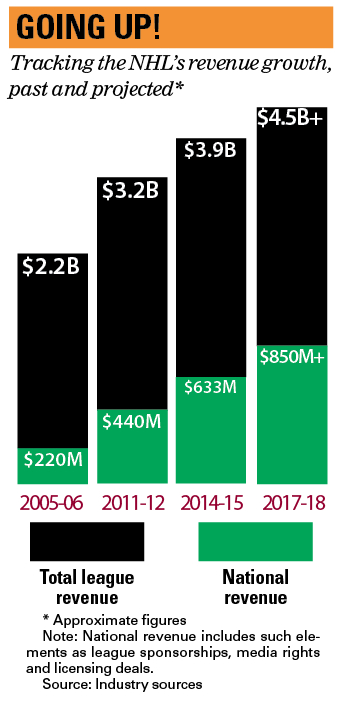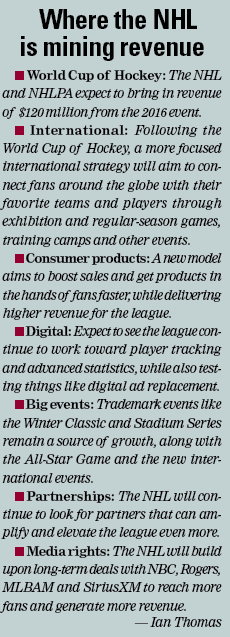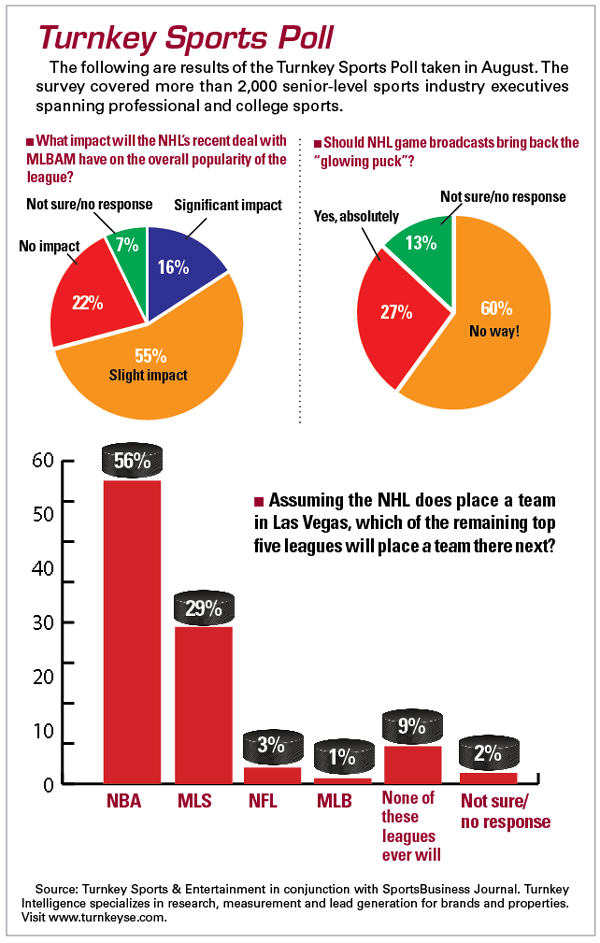For the last few years, the NHL has built what Commissioner Gary Bettman says is a solid foundation. From a 10-year collective-bargaining agreement signed with the players union in 2013 (the league’s longest to date), to the broadcast contracts with NBC and Rogers, to rule changes to improve the quality of the game, the league has put all of those pieces into place.
Now it’s paying off. Not only is the league poised to top $4 billion in revenue in the season ahead, it is forecasting to top $4.5 billion by the 2017-18 season.
“We’re now able to put building blocks on top of that foundation,” Bettman said. “And the good news is, those
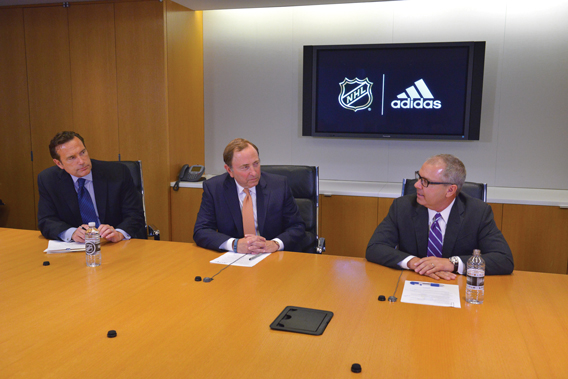 |
The deals keep coming for the NHL. Last week Commissioner Gary Bettman (center), COO John Collins (left) and Mark King from Adidas were outlining a new apparel deal.
Photo by: Getty Images |
building blocks are ever ascending in height, and are strong and stable — perhaps the strongest they’ve ever been.”
The league is benefiting from a sharp rise in national revenue, which includes leaguewide sponsorships, media rights deals and licensing. In 2005-06, national revenue accounted for about 7 percent of total league revenue, but now makes up nearly 20 percent of that figure. In addition, national revenue has grown about 20 percent a year, while the local team revenue that makes up the rest of the league’s total revenue figure has grown about 4 percent a year.
The signs of this growth include partnerships with GoPro, SAP, DraftKings, MLB Advanced Media and Adidas, as well as renewals with Bridgestone and Sirius XM. There’s also the relaunch of the World Cup of Hockey, set for 2016.
“More and more people and enterprises are recognizing the value of NHL hockey, the strength of our demographics, the quality of our players and the compelling nature of our game,” Bettman said.
Global push
Going forward, the NHL plans to continue its strategy of building scale both domestically and overseas.
Perhaps the most visible element will be the World Cup of Hockey, an eight-team international tournament the league will operate with the NHL Players’ Association in Toronto prior to the start of the 2016-17 season. Revenue for that tournament is projected to top $120 million, which will be split evenly between the league and players.
The league hopes the tournament will become a staple event every four years or so. While the event will certainly provide an economic boost for the league, it is just one part of a much larger plan to further connect with fans outside of North America.
“We have a history of doing international competitions jointly with the players’ association; our players love representing their countries,” Bettman said. “We also think this will provide a foundation to do more internationally, reflecting the fact that we are the most international sports league in North America.”
While the exact plans of what that foundation will be are still in the works, the expectation is that the league and all its teams will have a more regular place outside of this continent. At the least, that will include hosting training camps, preseason games and regular-season games.
While the NHL has played regular-season games internationally before — most recently in 2011 under the NHL Premiere banner — the league often felt its resources were spread too thinly and didn’t capitalize as best as possible. With the reintroduction of the concept, those games could mirror the approach taken when hosting Stadium Series outdoor games, with further emphasis placed on the fan experience and atmosphere.
There are also plans to launch a Ryder Cup-style event as soon as 2018, featuring 50 NHL players in a North America vs. Europe short-series. Being pitched as a showcase for the best hockey talent in the world, the league and NHLPA believe the event would be well-received in cities like London or Berlin.
With these additional big events, the NHL will be able to present new opportunities for its partners to reach international audiences, as well as its current North American fan base. There may even be the addition of new markets in North America as well, as the league is exploring expansion for the first time since 2000. Currently, the NHL is reviewing bids from groups in Las Vegas and Quebec City, with a decision likely to come from the board of governors by the end of the year.
New partnerships
A large part of the NHL’s strategy is leveraging its relationships with business partners to further amplify the growth initiatives.
“Aligning with the right strategic partners is critical,” NHL Chief Operating Officer John Collins said. “Look at
NBC’s role in the Winter Classic — without them it doesn’t happen. You need partners who will embrace these ideas.”
Perhaps no partnerships better reflect that than two of the latest — MLBAM and Adidas.
With MLBAM, not only will the NHL receive $100 million annually for media rights it previously hadn’t sold, it will be able to refocus its own efforts on producing and creating content — what the league feels is its bread and butter— utilizing the tech company’s platforms and digital assets instead of having to divert resources to manage its own.
That deal also aligns them with a league and property that perhaps better understands certain international markets where the NHL has less exposure but would like more, such as Asia. MLBAM also has vast experience with different elements of player tracking and digital in-game advertising, two areas the NHL has been testing and for which it has high hopes.
Adidas also helps the NHL move into additional markets, with a healthy retail presence throughout Europe, and brings expertise and brand awareness in sports apparel.
The new deal with Adidas has allowed the NHL to restructure its consumer products business, opening up the ability to partner with new companies and try a new, innovative approach (see story).
Labor relationship
For as successful as the league has been with its business plan thus far, no one element is perhaps as crucial to continuing that than the relationship it has with the NHLPA.
“For a long period of time, I would not characterize that relationship as a good one,” said Deputy Commissioner Bill Daly. “But now, this is the best it’s been in the 20 years I’ve been here.”
The strength of that renewed bond is evident in the 10-year CBA that was signed in 2013. It is certainly an added benefit that the new CBA calls for players to see a 50 percent share of hockey-related revenue.
“The whole nature of the system is that the players share in it as well, so they recognize the link between these new initiatives and efforts and growing the business,” Daly said. “I’m not sure that mindset was there before.”
Daly credited NHLPA Executive Director Don Fehr, who brought stability and guidance to a union that had essentially gone through five directors in the previous five years.
“If you look at the World Cup, we’ve been working really closely on the business side with Don and the PA, and I think that helps the overall relationship,” Daly said. “It helps build trust, and we’re able to focus on working together to grow the game, not looking into a new CBA conflict.”
The level of solidarity is even visible from the owner’s suite.
“There is a real high level of trust and sharing of best practices and collaboration, the highest level at least since I’ve been at the league,” said Ted Leonsis, who has owned the Washington Capitals since 1999. “Sometimes in leagues you feel the league office is corporate, and you’re out there running a franchise — the NHL has done a magnificent job in creating a true partnership with its owners.”
Leonsis said he’s been impressed by the league’s strategic approach.
“I’ve been impressed at how nimble and how calculated the decision making has been, and how when they find something that is good, they really know how to scale it,” he said. “We’ve gone from one Winter Classic to a series of outdoor games, from one major sponsor to multiple, and from having digital rights that perhaps some people thought should just be thrown in a media deal now at the center of an exciting new partnership with BAM.”
With signs of bigger things, Leonsis said he has complete faith in the direction of the league.
“When you look at what the league has done, they’ve earned the trust and confidence of all the owners, because they’ve executed well and there’s only blinking green lights on the big things the league has promised us,” he said. “When you look at all the things that are coalescing together, it’s made the NHL, if you will, a real growth stock.”
Leading the effort
Overseen by Commissioner Gary Bettman, a number of key NHL executives have helped to drive the league’s revenue strategy, including Deputy Commissioner Bill Daly; CMO Brian Jennings; Keith Wachtel, executive vice president of global partnerships; David Proper, executive vice president of business affairs; Stephen McArdle, executive vice president of digital media and strategic planning; and Don Renzulli, executive vice president of events.
But perhaps no executive has played a bigger role in the league’s continued growth than COO John Collins, who
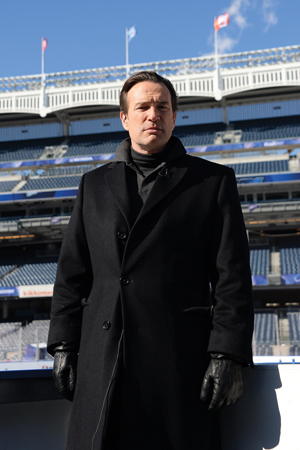 |
John Collins joined the NHL in 2006 to guide the league’s growth strategies.
Photo by: Getty Images |
still follows his initial instructions from Bettman.
“Gary had a mandate — to build a strategy that would fulfill the global brand ambition that he had for the league,” Collins said. “He wanted to think big, and act big.”
In 2006, Bettman had been looking to beef up the business side of the league, with the belief that there was unlocked potential in the marketing and promotion of the game, as well as with its media distribution platforms.
Collins and Bettman scheduled a meeting in the commissioner’s midtown Manhattan office, but it wasn’t a job interview — the former NFL executive wanted to sit down with Bettman to have a conversation about marketing, media and perhaps what his next move should be.
After they shook hands and Collins left, Bettman quickly reflected on their conversation. About 15 minutes later, he called Collins and asked if he was still in Manhattan and, if so, did he want to stop back in his office and talk about joining the league.
“I remember telling him, ‘I’m giving you a canvas, and you’re getting the paint, but don’t go over the edges,’” Bettman said with a laugh.
Where to next or the NHL?
Here’s how the two markets being targeted for possible expansion size up:
Las Vegas
 |
| Photo by: Getty Images |
Ownership: Black Knight Sports and Entertainment (Bill Foley, Maloof family)
Arena: Las Vegas Arena, a $375 million multipurpose arena being built by MGM Resorts International and AEG near the Las Vegas Strip that is set to open next spring (17,500 capacity for hockey).
Population: 613,599
Unemployment rate: 7.0%
Average income: $51,143
Other teams: PCL Las Vegas 51s, MASL Las Vegas Legends, NCAA UNLV
Quebec City
 |
| Photo by: Getty Images |
Ownership: Quebecor
Arena: Videotron Centre, a new $370 million publicly funded arena (18,259 capacity for hockey).
Population: 791,934
Unemployment rate: 4.9%
Average income: $42,442
Other teams: C-A Québec Les Capitales, QMJHL Quebec Remparts.
Source: SportsBusiness Journal research



